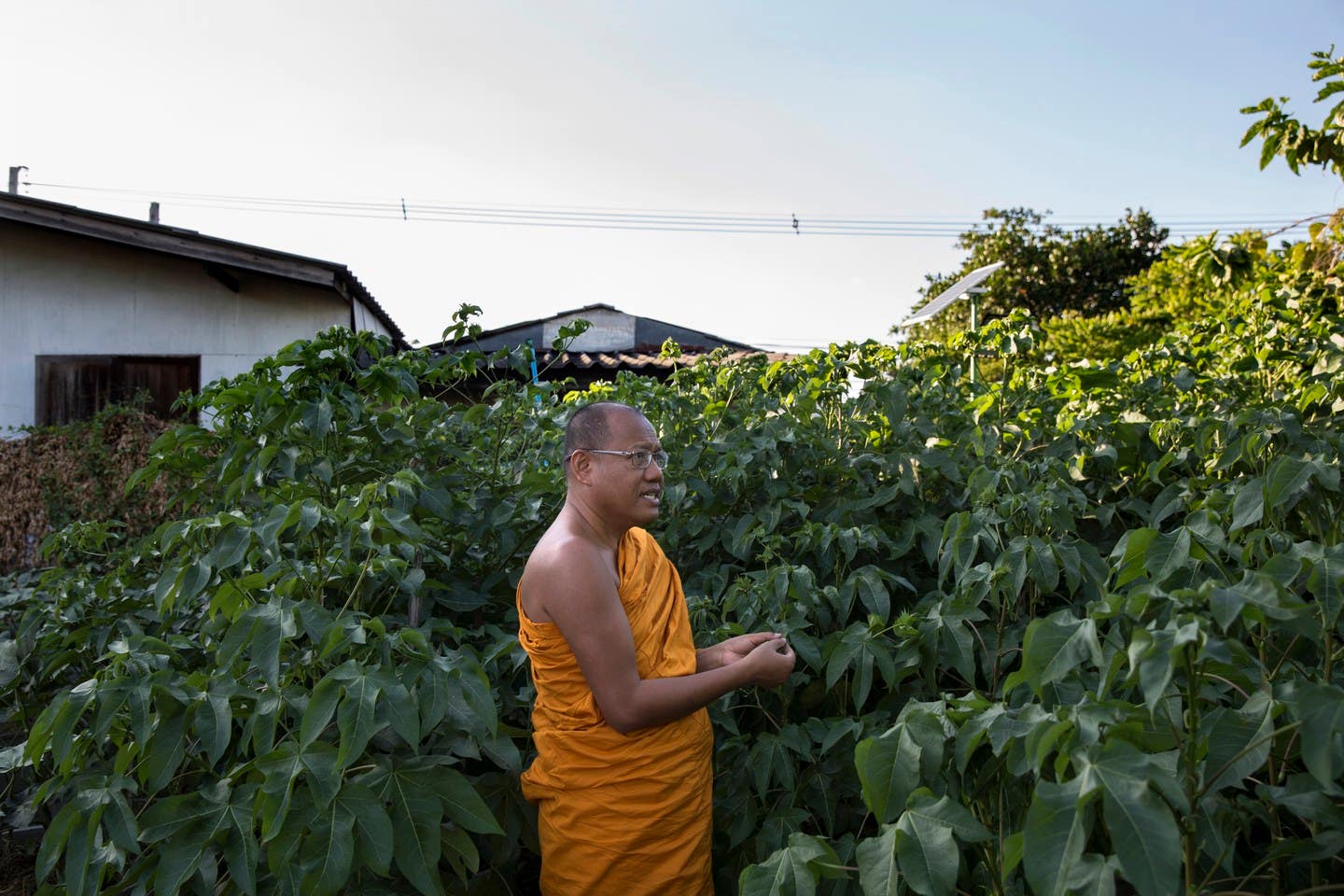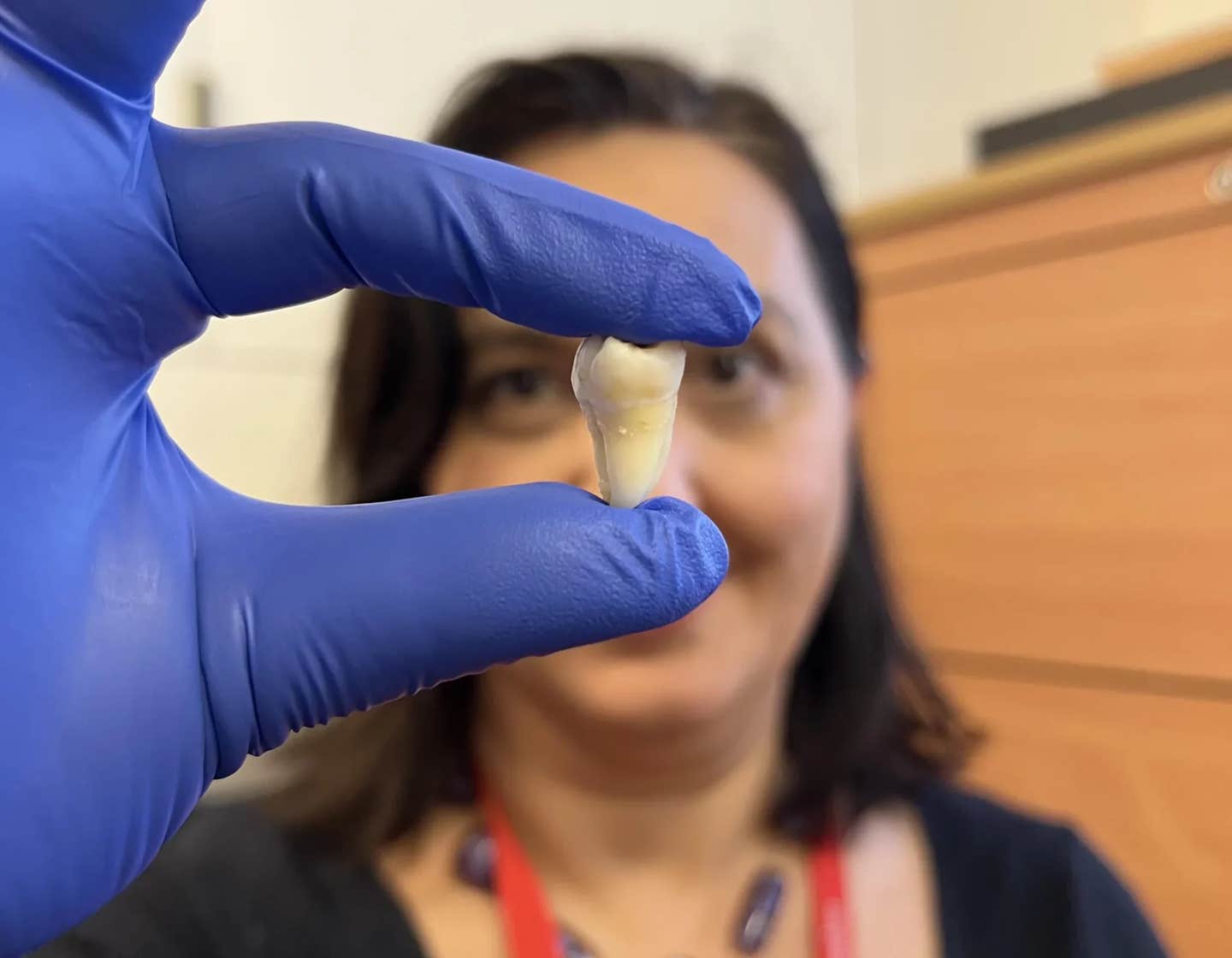Meet the Buddhist monk making PPE and robes out of recycled plastic bottles
Phra Mahapranom Dhammalangkaro made it his mission to turn the city’s plastic waste into robes and PPE for all of Thailand.

[Sept 3, 2021: Siukei Cheung]
Phra Mahapranom Dhammalangaro, Abbot of Chak Deang Temple stands amongst cotton plants that he has grown. (CREDIT: Luke Duggleby / Redux Pictures)
Phra Mahapranom Dhammalangkaro is the acting abbot of Chak Daeng Temple just south of Bangkok. And he’s made it his mission to turn the city’s waste into robes and PPE. He now helps to process 10 tonnes of plastic waste every month. But like all big projects, his started off as a small idea – one that has a 2,600-year history.
Since PET plastic can be made into fabric, Dhammalangkaro originally came up with the idea of making it into monastic robes. He speaks at Chak Daeng Temple, located just south of Bangkok, where he works as the acting abbot.
Transforming plastic into fabric may be a contemporary solution to the problems of the present day, but the idea of making monastic robes out of rubbish was first conceived 2,600 years ago by the Buddha, who encouraged ordained monks to fashion their robes out of cloth from scrap heaps and graveyards.
According to the Tripitaka (Buddhist scriptures), the material was boiled in water along with astringent bark to kill the germs and then dyed with fruit. “The Buddha did it this way,” Dhammalangkaro says. “But when it comes to plastics, why do people throw them away?”
How did it start?
In 2005, Phra Mahapranom Dhammalangkaro moved to Bangkok to teach Buddhism and manage Chak Daeng’s temple grounds. “It was full of garbage at the time,” he remembers. Plastic was dealt with in one of two ways: by burning it or throwing it away.
“Back then, people thought that when they threw garbage in the river, then it’s done,” Dhammalangkaro says. “But fish died, turtles died and dugongs died.” The other method was to burn them, but this created a lot of pollution. “We didn’t know what to do with them,” he says. “[Then] I learned that PET plastic can be made into fabric.”
“When we first started doing it, nobody believed it. There were people who did not know this could be possible.” Dhammalangkaro says. “That’s why we need to give them knowledge. When they have knowledge, they will know that it is easy to deal with plastic.”
Recycling the Buddhist way
Temple workers assemble the bottles and compress them into bales, before shipping them off to a factory to have them crushed and made into fibres. They are then sent to a separate factory, where the fibres are woven into fabric. Back at Chak Daeng, the fabrics are then transformed into robes and now PPE by the workers manning the sewing station.
A man sews a PPE suit for Buddhist monks who work as volunteers. (CREDIT: REUTERS / Soe Zeya Tun)
There are around 30 villagers working at the temple. Together they transform around 10 tonnes of plastic each month.
The temple has had to learn other recycling methods: they transform foams into glue to make shoes; others mix foams with cement to produce plant pots and worm bricks; and another station makes buoys to collect garbage from the rivers.
Switching Gears Towards Making PPE
Thailand has recorded more than 1.1 million coronavirus infections and 12,000 deaths since April this year.
To meet this challenge and with an abundance of plastic waste but a scarcity of personal protective equipment (PPE), the monks have expanded their operations to upcycle bottles into protective clothing for people at risk of coronavirus infection.
Millions of plastic bottles have been collected, shredded and turned into threads to be weaved into fabrics eventually used for PPE, either for hospitals or Buddhist temples, where monks have been cremating coronavirus victims.
According to Dhammalangkaro, “There are times where it is very difficult to get hold of PPE suits, sometimes even if you have money, you can’t buy,”
Temple volunteers have been sewing orange PPE suits for monks, undertakers and scavengers, and PPEs are being sent to thousands of temples in need across the country.
Though these are not medical-grade, they provide at least some protection for those potentially exposed to COVID-19, and one PPE suit can be made using only 18 plastic bottles.
A Buddhist monk wears a PPE suit, as Bangkok city's administration and temples drive efforts to encourage the public to donate plastic bottles. (CREDIT: REUTERS/Soe Zeya Tun)
Some 18 million plastic bottles have been used since the middle of last year to make fabric for PPEs, which have been sent to hospitals around the country, he added.
“We’re saving lives and the environment as well,” Dhammalangkaro said.
For more environmental stories check out our Green Impact section at The Brighter Side of News.
Like these kind of feel good stories? Get the Brighter Side of News' newsletter.
Tags: #Global_Good_news, #Green_Good_News, #Medical_News, #Recycling, #Plastic, #PPE, #Clothing, #The_Brighter_Side_of_News
Joseph Shavit
Head Science News Writer | Communicating Innovation & Discovery
Based in Los Angeles, Joseph Shavit is an accomplished science journalist, head science news writer and co-founder at The Brighter Side of News, where he translates cutting-edge discoveries into compelling stories for a broad audience. With a strong background spanning science, business, product management, media leadership, and entrepreneurship, Joseph brings a unique perspective to science communication. His expertise allows him to uncover the intersection of technological advancements and market potential, shedding light on how groundbreaking research evolves into transformative products and industries.



